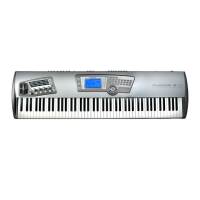ALESIS FUSION
ANALOG SYNTHESIS TUTORIAL
With that in mind, in 1971, Dr Robert Moog (largely regarded as the father of modern
synthesis)
released the seminal MiniMoog synthesiser. The oscillators, filters, amplifiers and
controllers
were ‘pre-patched’ and all connections switched on and off using front panel switches.
Although it had no patch memories to store sounds, the MiniMoog was portable and
considerably easier to use both on stage and in the studio. The MiniMoog spawned
all sorts of
similar products from competing manufacturers such as ARP (their Odyssey) and,
of course,
Japanese manufacturers such as Roland, Yamaha and Korg who were making their
first
synthesisers in the early to mid-70s.
Of course,
at this time, all synthesisers were ‘monophonic’
1
- that is, you could only play one
note at a time but in the mid-70s, we saw the release of ‘polyphonic’ synthesisers that
could
play as many as eight (!!) notes simultaneously. The first
of these was the Yamaha CS80 but it
was Sequential Circuits ‘Prophet 5’ that set the pace for the next generation of synthesisers.
Featuring 5-note polyphony,
the Prophet 5 had one more trick up its sleeve - the settings of
the front
panel controls could be stored and recalled with a button press allowing you to flick
between different sounds
quickly and easily. However, worthy of note is the fact that the
structure of each of the Prophet’s voices was pretty much exactly the same as the MiniMoog’s.
Other manufacturers released similar products all using the same
basic layout as the Minimoog
and development stayed rather dormant with no major innovations
until 1982 when Yamaha
released the legendary DX7 FM synthesiser.
This was also the first synthesiser to feature the
new ‘Musical Instrument Digital Interface’ otherwise known as
MIDI. Analogue synthesisers fell
from grace almost overnight and you
could barely give them away during the 80s - no-one
wanted that analog sound anymore; instead, they wanted the fashionable FM sounds that
littered almost every record of the time. The
DX7 was an immediate success offering 16-voice
polyphony (unheard of in those days),
a velocity sensitive keyboard (also very rare back then)
and loads of playable presets for about a fifth of the cost of an analog polysynth!!!
In the mid-80s, affordable
sampling also took off with products such as the Akai S900 and so
you’d think the fate of analog synthesisers was sealed.
However, in the 90s, impoverished musicians were picking up these
analog relics dirt cheap in
second-hand shops or classifieds and
they quickly became popular again. People also re
-
discovered their rich, warm
and vibrant sound (especially after a decade of clean and detailed
FM and static samples). As a result, prices soon started to escalate
and instruments you
couldn’t give away a few years earlier were selling for more than their original price!
However, these old things were unreliable (some notoriously so) and
costly to maintain. It was
also difficult to locate
good examples of the old instruments (and, of course, they didn’t have
MIDI which by now, had become a vital part of the music
making process). But still they
remained popular and these ‘old’ synths were now the ‘new’ things to have!
Advances in computing power meant
that is was possible to ‘model’ (i.e. re-create) the sound
of analog synths using advanced digital sound
processing (DSP) and so the ‘virtual analog’
synth was born. Offering the characteristic richness of
genuine analog synths, they overcame
all of the reliability problems as
well as offering greater facilities and higher polyphony at much
lower cost.
Which brings us to
the present day. The VA (virtual analog) synth in Fusion is a powerful
engine that offers a truly comprehensive specification
that outperforms almost all of the old
analog synths of yesteryear whilst retaining the warmth and character of those old classics.
Let’s now look at the various components that make up a typical analog synthesiser.
1
Some offered the ability to play two notes at a time but were compromised.
Introduction
Page 2

